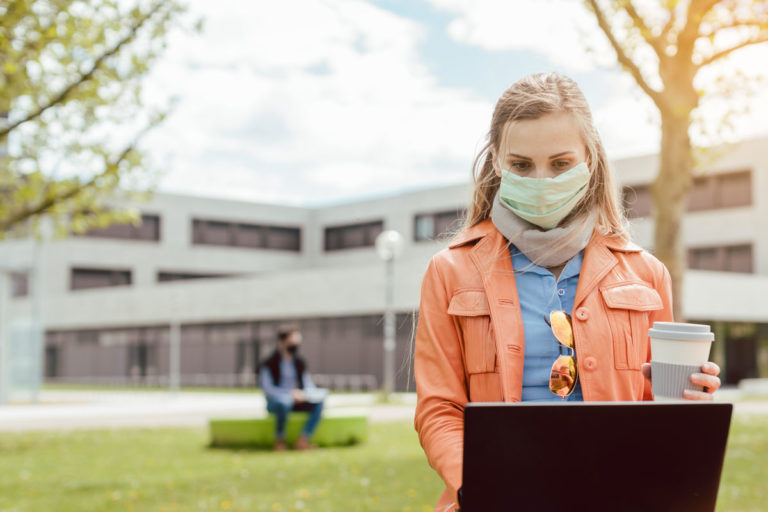Table of Contents
Eighty-nine percent of college students are experiencing anxiety as a result of COVID-19. It’s clear that the pandemic and the accompanying lockdown measures changed the college experience for students. But, what exactly happened to cause 4 out 5 college students to say they’re still stressed by the effects of coronavirus one year later?
The challenges students faced during COVID-19
The sudden shift to online learning in spring 2020 made it obvious that existing inequities in higher education had only gotten worse. Residential students were abruptly told to pack up their belongings and leave campus, sometimes without a goodbye to friends and faculty who played a pivotal role in their sense of community.
1. Housing insecurities
For housing-insecure students, there was no safe home to return to, or no home at all. Even if students did have somewhere to go, many didn’t have the resources to leave at a moment’s notice or have a quiet space to study once they got home. The abrupt exodus from residence halls also raised issues of refunds for students who left early.
2. Food insecurities
Campus closures and the shift to online classes left some students with food insecurities. And, food pantries were overrun, making them more difficult to access. Events students were previously able to attend and get meals was no longer an option. Campus closures and the subsequent financial consequences left the country’s most vulnerable students without the means to meet their basic needs, making it nearly impossible to continue their education.
3. Reliable broadband connection
The pandemic also exposed how many students lack access to affordable and reliable broadband. Traditionally underserved students often relied on on-campus resources to complete their education — like libraries, computer labs, and Wi-Fi. These were lost when campuses shuttered. Too many students of color, as well as low-income, rural, and Native American students, struggled to log into class due to lack of internet accessibility. Many of these same students also lacked computers and cameras and had to resort to using cell phones instead. Of course, some institutions made heroic efforts to get laptops and hotspots to students. But even so, staying in school remotely proved difficult for many.
4. Accessibility for students with disabilities
The pandemic put a spotlight on how necessities — internet, food, housing, access — are essential for students to access the benefits of higher education. And for historically underserved students, this disparity exacerbated the challenges and will undoubtedly have continued consequences as they ease back into “normal.”
Remote learning and education uncertainty
A common theme across higher education during COVID-19 is how differently college administrators, faculty, and students perceived the transition to online learning. Many college administrators viewed the spring transition to online positively, as they believed faculty and students adapted quickly. In a survey conducted by the American Council on Education (ACE), nearly 86% of college presidents said their institutions transitioned to remote learning “well.” The remaining 14% percent reported that the transition to fully remote instruction went “somewhat well.” Not one president reported their instruction transition went poorly. This is true — in a matter of days, faculty pivoted to offer course material online with little to no training. However, the pivot to online learning was widely considered a disaster from a student’s perspective.
Particularly early on, classes were difficult for a number of students with professors who didn’t know how to use their college’s learning management system and had to receive and submit assignments through email. A significant amount of class time was spent sorting out technical issues for many students, contributing to an additional layer of stress. Creating a sense of community in a virtual space was also a challenge during COVID-19. Isolation due to social distancing seems to be connected to students’ lack of motivation to continue with their coursework.
Clearly, 2020 was difficult for those unfamiliar with online learning, and most students and educators struggled to make the transition.
Discover how telehealth improves campus health.
Missed milestones and connections
COVID-19 also caused university students and their family members to miss or delay milestones they typically look forward to. Most of the events marking their high school career culmination — such as prom, spring break, senior week festivities, and graduation ceremonies — were canceled for graduating high schoolers. Students planning to attend college weren’t able to physically visit college campuses to make their choices. For athletes, there was no spring season and for musical and theatrical artists, no final performances.
Benchmarks like quinceañaras, sweet sixteen birthday parties, and turning 18 were sometimes held in quarantine, as were first-time milestones such as getting a driver’s license. Also, students weren’t able to participate in summer internships to strengthen their college applications, apply for summer jobs, or employment after graduation. These sorts of opportunities were often delayed and sometimes missed altogether.
Participation in activities such as commencement, sports competitions, theater and musical performances promote opportunities for young people to develop peer relationships. This is an invaluable developmental period as they shift from family-focused to peer-focused social interactions. Involvement in sports teams, extracurricular activities, and holding a job facilitate this development and teach teens about cooperation, planning and organizing their time, responsibility, and resolving conflict.
Participation in milestones is associated with positive outcomes over the course of later development, including better physical and mental health. It’s through participating in milestones that teens become more independent, growing in the cognitive, social, emotional and academic skills, which foster their wellness and prepare them for adulthood. While the lack of these milestones are stressors, higher education can reduce anxiety for students by restoring hope that these events will surely begin again as we move past the lockdown measures.
What higher education can do now in response
Surely, the pandemic worsened circumstances for the mental health of college students. What can colleges and universities do to help students address these stressors from the past year?
1. Offer virtual options for advising and connecting with faculty
2. Support innovative internship and research solutions
3. Expand access to counseling and mental health resources
College counseling centers should continue providing students with counseling services at a distance. Telehealth services are effective in treating anxiety and depressive symptoms, and implementing telehealth services facilitates the delivery of counseling services to address students’ pressing mental health concerns. Counseling centers can also provide options for students to join online support groups that enable them to share common concerns and receive social support. Further, university counseling centers and other departments should rally to develop and pass public health messaging onto students, share coping resources, and encourage them to take action to protect their mental health.
4. Raise awareness and empower students to advocate for their mental health
5. Create community partnerships to connect students to need resources
6. Engage organizations that promote student health and well-being
A RAND study by Active Minds found that merely being familiar with that organization was associated with a significant improvement in knowledge of mental health issues and a decrease in stigma in first-year students. Such changes can improve campus climate around mental health, in turn, increasing the likelihood of students seeking help. Given the skill of these organizations to remain engaged with students both on and off-campus, campuses should engage these types of organizations around solutions to best support students during the pandemic and beyond.
7. Set up partnerships with crisis centers
COVID-19 highlighted a system that was already struggling to meet the needs of young adults in this country, and has brought new interest to the issues surrounding mental health. Mental health advocates should seize this moment to raise awareness of the ongoing mental health needs of college students and also invest in long-term solutions that will continue to support students well beyond the pandemic.
What do college students think about telehealth?
Recent findings indicated students view telehealth services as convenient and flexible. Without concern for coordinating schedules, waitlists or traveling to a clinic, college student participants in telehealth services found electronic support to be consistently available at their convenience. There’s also the potential benefit of avoiding costs for transportation, childcare, or missed work to attend in-person appointments.
College students consistently register satisfaction with the usability of telehealth services. Over 90% of college students use the internet every day, and 86% of college students regularly use a smartphone. Not surprisingly, students report the convenience, acceptability, and usability of mobile phone apps for mental health interventions, including those for mindfulness, drinking cessation, depression, and anxiety.
Student respondents across a variety of studies consistently describe a high level of satisfaction with telehealth services, including automated messaging platforms and self-directed therapy platforms. And, telehealth services offer opportunities for college students to avoid the stigma of seeking mental health treatment. This is an obstacle particularly for minority students, who are less likely than White students to utilize mental health services despite experiencing similar or elevated rates of markers of mental illness such as suicidality, suicide attempt, or self-harm.
Telehealth services can also provide college students a sense of ownership over their psychological struggles. Survey results confirm that students feel a sense of control over the pace of the intervention and appreciate the casual nature in which they can receive help, compared to if they were to seek help at a counseling center.
With skyrocketing costs, regulatory changes, and evolving technology creating new challenges and opportunities for healthcare, consider virtual healthcare as a means to improve mental health support on your campus while simultaneously reducing costs. A recent study confirms telehealth can expand care while reducing costs. The study was only the latest in a growing body of evidence that shows one of the value propositions of telehealth is a cost reduction and simultaneous growth in patient access to needed care and support systems.
At TimelyCare, COVID-19 deepened our understanding of the efficacy of telehealth for education systems and its important role in the well-being of college students. The Coker Group conducted a telehealth survey evaluating how healthcare organizations adopt, implement, and utilize telehealth solutions. Results confirm that telehealth will be essential for the short-term and long-term delivery of healthcare. In other words, telehealth is a reliable, long-term solution to providing both medical and mental health care for your students.
The health of your campus is directly related to the success of your students. When care is easy and accessible, students are empowered to take control of their medical health and mental well-being. Contact TimelyCare today to explore how a customized telehealth solution can help your students thrive.
Let's Talk About Student Mental Health
Our experts are ready to learn more about your school and share how your campus can thrive by integrating telehealth.






